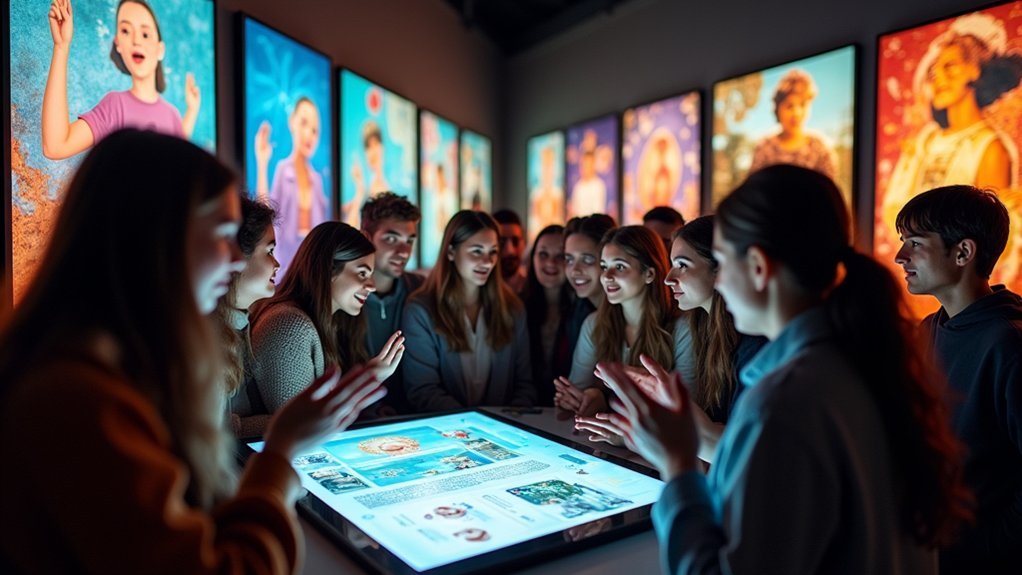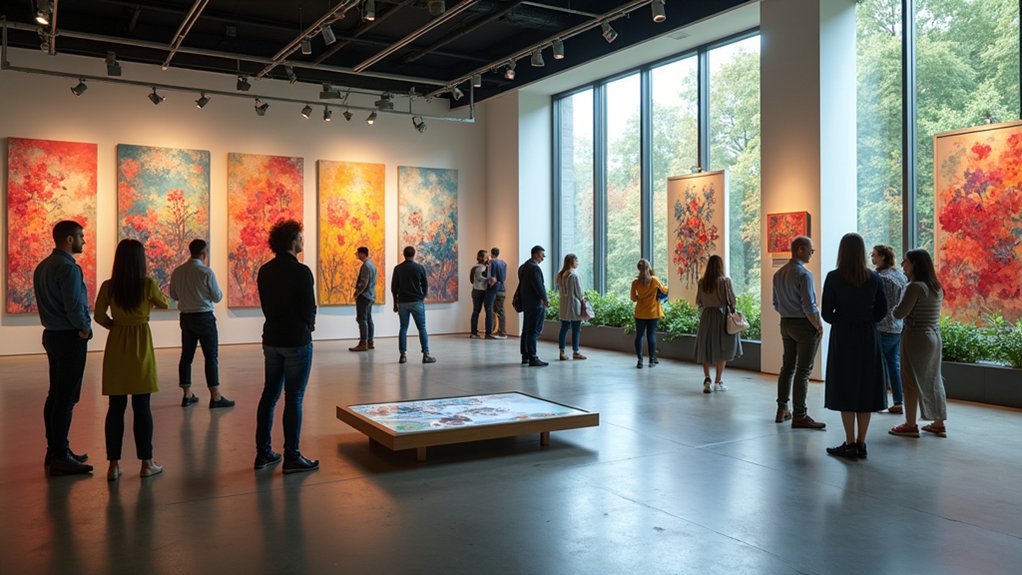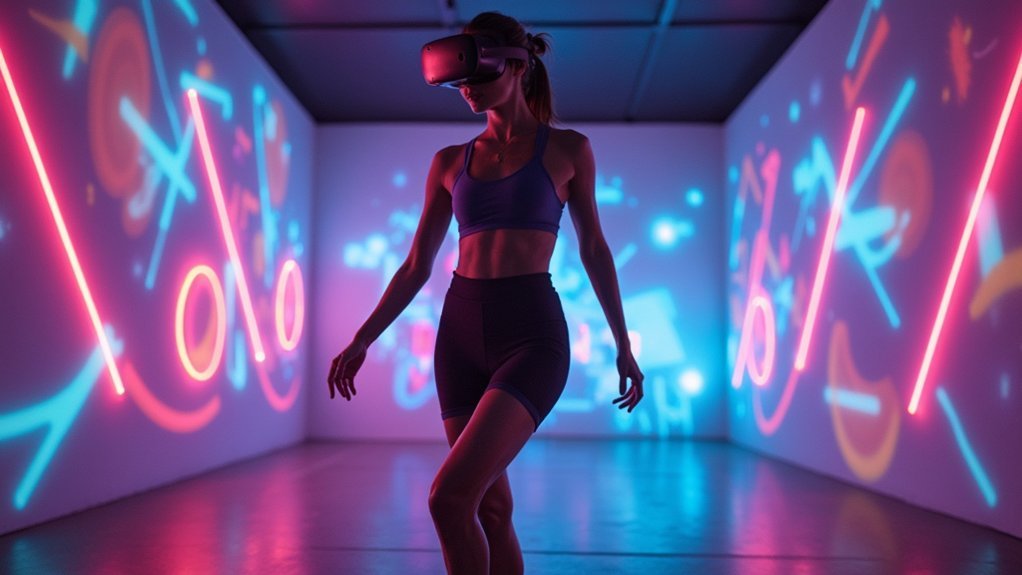You’ll discover that art gallery content libraries are transforming cultural access by preserving precious heritage through high-resolution digital imaging and cloud storage, democratizing world-renowned collections beyond geographical barriers, and fostering genuine community engagement through interactive virtual exhibitions. They’re empowering artists with innovative platforms while supporting educational initiatives that enhance visual literacy skills. These digital bridges connect traditional art forms with cutting-edge technology, creating immersive experiences that sustain artistic legacies. Explore how these revolutionary changes reshape cultural appreciation.
Preserving Cultural Heritage in Digital Spaces

While physical artworks face constant threats from time, environmental damage, and human conflict, digital content libraries offer an unprecedented solution for safeguarding our cultural treasures.
You’ll find that these libraries matter because they’re transforming how we preserve artworks, artifacts, and historical documents that might otherwise vanish forever. Through high-resolution imaging and sophisticated metadata tagging, you’re accessing accurately represented cultural materials that remain searchable for future generations.
Digital libraries revolutionize cultural preservation, transforming vulnerable artworks and documents into searchable, high-resolution archives for future generations.
When you explore these digital platforms, you’re witnessing collaborative efforts between cultural institutions creating thorough educational resources.
These initiatives don’t just archive collections—they’re actively promoting diverse cultural narratives while ensuring scholarly research continues uninterrupted. You’re benefiting from technology that mitigates physical degradation risks, guaranteeing cultural heritage survives for global appreciation.
Democratizing Access to Artistic Collections
Because traditional art galleries have historically served privileged audiences with the means to travel and pay admission fees, digital content libraries are revolutionizing who can experience masterpieces from around the world.
You can now explore collections from renowned museums without leaving your home or worrying about costs. These platforms break down geographical and financial barriers that previously limited access to art.
When you browse art in libraries online, you’re accessing educational resources including artist biographies and contextual information that deepen your understanding.
You’ll discover these digital spaces encourage community participation through collaborative projects, giving you ownership in cultural preservation.
Research shows that exposure to online collections actually increases your likelihood of visiting physical galleries, strengthening local art communities.
Fostering Community Engagement Through Virtual Exhibitions

You can transform your gallery’s virtual exhibitions into powerful community-building tools that extend far beyond traditional viewing experiences.
When you incorporate interactive features like live-streamed artist discussions and immersive digital tours, you’re creating opportunities for real-time dialogue that connects viewers across geographic boundaries.
These digital platforms don’t just display art—they’re fostering genuine engagement by inviting community members to participate actively in cultural conversations and share their own perspectives.
Digital Access Expansion
As digital technologies reshape how communities access cultural experiences, art galleries are discovering that virtual exhibitions can transform isolated viewers into engaged participants regardless of their physical location.
You’ll find that online platforms break down geographical barriers that once prevented diverse communities from experiencing world-class collections. When you explore virtual exhibitions, you’re joining thousands of others who might never have accessed these cultural treasures otherwise.
These digital spaces don’t just display artwork—they create opportunities for meaningful engagement through interactive features like guided tours and artist interviews.
You can dive deeper into collections through extensive content libraries that provide high-quality images, artist statements, and scholarly resources. This expanded access democratizes cultural participation, ensuring that art galleries serve broader, more inclusive communities than ever before.
Interactive Online Experiences
Building on these expanded access opportunities, galleries now incorporate dynamic interactive features that transform passive viewing into active community participation.
Interactive online experiences revolutionize how you engage with art through multimedia elements like videos, timelines, and live Q&A sessions with curators or an artist in residence.
These platforms create inclusive environments where you can:
- Submit interpretations – Share your perspective on artworks through user-generated content
- Participate in real-time discussions – Join live sessions with artists and fellow viewers
- Access analytics-driven content – Experience personalized recommendations based on community preferences
You’ll find that virtual exhibitions generate higher social media engagement, with galleries tracking your behavior to enhance future programming.
This data-driven approach guarantees community-focused experiences that reflect your interests while fostering meaningful connections between viewers, artists, and institutions.
Supporting Educational Initiatives and Literacy Programs
When art gallery content libraries partner with educational institutions, they transform traditional learning by providing rich visual resources that enhance curriculum development across multiple subjects.
These libraries offer you access to diverse artworks that support educational goals while promoting visual literacy skills essential for academic success.
You’ll find that collaborative projects between galleries and libraries create innovative approaches to literacy development.
Artist-designed book share stations engage your community through creative, interactive experiences that make reading more appealing and accessible.
Through workshops and curated exhibitions emphasizing art’s role in storytelling, these content libraries help you develop both reading and writing skills.
You’ll participate in hands-on experiences that foster critical thinking while building lifelong appreciation for art and literature.
Empowering Artists With New Exhibition Platforms

While traditional galleries often present barriers through high rental costs and exclusive selection processes, art gallery content libraries offer you revolutionary exhibition platforms that democratize artistic exposure.
These accessible venues connect you with diverse audiences beyond typical gallery-goers, expanding your reach considerably.
You’ll discover these platforms support various artistic mediums, including digital and interactive works that showcase your creativity innovatively.
Through partnerships with community spaces, you’ll gain increased visibility and meaningful audience interactions that enrich your practice.
Gallery shows in libraries provide three key advantages:
- Community workshops that let you engage directly with the public
- Professional development opportunities through educational events
- Enhanced cultural connections that build shared artistic appreciation
This support fosters greater community involvement while promoting arts appreciation and strengthening cultural identity.
Building Bridges Between Technology and Traditional Art Forms
You’ll find that digital art preservation methods protect traditional masterpieces through high-resolution scanning and climate-controlled storage systems that guarantee artworks survive for centuries.
Interactive technology integration transforms how you experience classic paintings and sculptures by adding touchscreen displays, motion sensors, and audio guides that reveal hidden layers of artistic meaning.
Virtual exhibition platforms let you explore renowned galleries from anywhere, combining traditional curation with immersive digital environments that make art accessible beyond physical walls.
Digital Art Preservation Methods
As technology reshapes how we experience and interact with art, digital preservation methods have become essential tools for safeguarding cultural heritage while making it accessible to global audiences.
You’ll find that modern digital art preservation methods utilize high-resolution imaging and scanning technologies to create precise reproductions of traditional artworks, ensuring their longevity for future generations.
These preservation techniques offer you several key advantages:
- Cloud storage solutions that safely back up digital files and reduce data loss risks
- Metadata tagging that provides important artwork information for cataloging and research
- Blockchain technology that authenticates ownership and prevents forgery
You can now access digital repositories and virtual galleries that create interactive experiences, allowing you to engage with artworks in immersive environments beyond physical limitations.
Interactive Technology Integration
Something remarkable happens when you step into a gallery equipped with interactive technology—the boundary between observer and participant dissolves entirely.
You’re no longer simply viewing art; you’re actively engaging with it through augmented reality experiences that reveal hidden layers of meaning and virtual reality installations that transport you into the artist’s vision.
These interactive displays invite you to create your own interpretations, while touchscreens and kiosks provide instant access to detailed artwork information and historical context.
You’ll find yourself spending more time exploring, drawn deeper into each exhibition.
This technology doesn’t replace traditional art appreciation—it amplifies it, making galleries more accessible to younger generations while maintaining the profound connection between human creativity and artistic expression that’s always defined great art.
Virtual Exhibition Platforms
While physical galleries remain treasured spaces for experiencing art, virtual exhibition platforms have revolutionized how we discover and engage with creative works from around the world.
You’re no longer limited by geographic boundaries when exploring diverse art forms and cultural expressions that matter most to you.
These platforms deliver powerful advantages that enhance your art discovery experience:
- Interactive features like 3D walkthroughs and augmented reality create immersive experiences beyond traditional viewing.
- Higher attendance rates with some virtual exhibitions reporting 200% increases compared to physical counterparts.
- Social sharing capabilities that let you easily promote artists and foster community dialogue.
Virtual exhibition platforms also provide galleries with valuable analytics about viewer demographics and engagement patterns, informing future exhibitions while connecting you with global artistic communities.
Creating Immersive Experiences for Diverse Audiences
Five key elements transform ordinary art gallery and library spaces into enchanting environments that speak to every visitor who walks through their doors.
You’ll discover interactive installations that invite hands-on exploration, breaking down traditional barriers between art and audience.
Public Library systems increasingly host workshops and artist talks, allowing you to connect personally with creators and their processes.
These spaces incorporate local narratives and community involvement, creating meaningful connections that reflect your shared histories and experiences.
The physical presence of art offers unique emotional and sensory engagement that digital can’t replicate, helping you form lasting memories.
Through collaborative projects and multidisciplinary exhibits, you’ll encounter diverse artistic expressions while engaging in conversations around relevant social issues that shape your community’s cultural landscape.
Sustaining Artistic Legacy for Future Generations
Beyond creating meaningful connections with today’s visitors, art gallery content libraries shoulder the profound responsibility of preserving artistic heritage for generations yet to come.
You’re witnessing institutions that transform into essential repositories, cataloging diverse artistic expressions while creating thorough documentation for academic research. These libraries don’t just store artwork—they preserve cultural and historical contexts that future scholars will need.
Art galleries evolve beyond exhibition spaces into vital cultural archives, safeguarding artistic legacies and contextual knowledge for future researchers and scholars.
Your art gallery’s digital preservation initiatives guarantee artworks remain accessible as technology evolves. Through collaborative projects with educational institutions, you’re fostering art literacy and inspiring new generations of artists.
Three key preservation strategies include:
- Digital archiving of multimedia resources and artist interviews
- Thorough cataloging systems for research accessibility
- Technology adaptation maintaining relevance in digital formats
Frequently Asked Questions
What Is the Importance of an Art Gallery?
You’ll discover diverse artistic expressions that enhance your cultural understanding while connecting with your community. Art galleries provide educational opportunities, boost local economies, preserve cultural heritage, and create spaces where you can engage directly with artists and their work.
Why Are Museums and Libraries Important?
You’ll find museums and libraries preserve cultural heritage while fostering lifelong learning. They boost local economies through tourism, create meaningful social connections, and offer hands-on experiences that digital alternatives can’t replicate.
Are Museums Still Relevant Today?
You’ll find museums absolutely relevant today because they’re creating jobs, boosting local economies, and offering irreplaceable hands-on experiences that digital platforms can’t match, while adapting with interactive technologies.
Why Are Art Museums Important to Society?
You’ll find art museums preserve cultural heritage while boosting local economies through tourism. They’ll provide educational opportunities, foster community connections, and inspire creativity that shapes contemporary culture, making them essential for society’s growth.





Leave a Reply